THE AWARD of Christmas Blitz JF-2014, Section A
In this section participated 63 problems. The quality of the tournament in this section is unique! It is probably a phenomenon in fairy composition-practice in the last few years!
The following problems were not included in the award: No.1. Gani Ganapathi – repetition of the key-moves in the first two solutions; No.10. Pierre Tritten & Sébastien Luce – here according to Popeye, short castling is not possible and I think that this concept is correct. When castling, the King must first be moved, then the Rook. This rule is well known from practical play. Therefore in No.10 where the imitator stands on g1, the move 1.0-0 is impossible because the first part of castling – Ke8->g8 cannot be imitated by Ig1. No.59. Alberto Armeni – author’s wrong diagram, no solution; No.65 Oliver Sick – h#5 – the maximum numbers of moves for helpmates is 4.
| No.61 Diyan Kostadinov Bulgaria Christmas Blitz JF-2014 Section A 1st Prize |
No.40 Sébastien Luce France Christmas Blitz JF-2014 Section A 2nd Prize |
No.31 Peter Harris South Africa Christmas Blitz JF-2014 Section A 3rd Prize Dedicated to Petko Petkov |
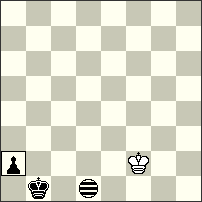 |
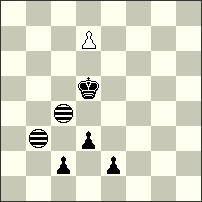 |
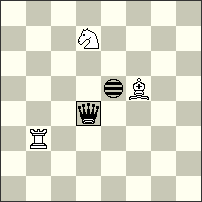 |
| h=2 (1+2+1i) b) from a) > Id1-e2 c) from b) > Kb1-g6 d) from c) > Kg6-b4 e) from d) > Kf2-d1 Imitator d1 Half-neutral Pa2 |
h#3.5 (1+4+2i) b) Pc2->d2; c) Pd7->h7 d) translation h1-g1 Imitators: b3, c4 Chameleon Chess White Maximummer (no white King) |
h#3.5 3 solutions (3+1+1i) Imitator e5 Maximummer Royal Qd4 (no white King) |
1st Prize – No.61 Diyan Kostadinov. A happy treasure trove! Super AUW with 5 promotions realised with only 3 pieces and 1 Imitator without repetition of white and black King’s moves! This wonderful Task is a good illustration of the potential of half-neutral pieces (here the bhPa2) in combination with Imitators! a) 1.Kb1-c2[Ie2] Kf2-e2[Id2] 2.hPa2-a1[Id1]=hR=nh nhRa1-b1[Ie1] = wh=; b) 1.hPa2-a1[Ie1]=hB=nh Kf2-e3[Id2] 2.Kb1-a2[Ic3] nhBa1-f6[Ih8]=wh =; c) 1.hPa2-a1[Ie1]=I Kf2-f3[Ie2,a2] 2.Kg6-h6[If2,b2] Kf3-e2[Ie1,a1] =; d) 1.hPa2-a1[Ie1]=hS=nh nhSa1-c2[Ig2]=whS + 2.Kb4-b3[Ig1] Kf2-g2[Ih1] =; e) 1.hPa2-a1[Ie1]=hQ=nh + Kd1-e2[If2] 2.Kb4-a3[Ie1] nhQa1-d1[Ih1]=wh =.
2nd Prize – №40 Sébastien Luce. A very interesting problem that shows White AUW and Black AUW. The play despite two restrictive fairy conditions is spectacular and difficult. Unfortunately, there is no cyclic Babson theme and the relations between white and black promotions in all four phases are: R/Q , B/B, S/R, Q/S. However, I believe that the problem deserves a high distinction. a) 1…d7-d8[Ib4,c5]=R 2.e2-e1[Ib3,c4]=Q Rd8-c8[Ia3,b4]=Q 3.Qe1-e2 [Ia4,b5]=S Qc8-c5 [Ia1,b2]=S 4.Se2-f4[Ib3,c4]=B Sc5-b3[Ia1,b2]=B #; b) 1…d7-d8[Ib4,c5]=B 2.Kd5-c5[Ia4,b5] Bd8-e7[Ib3,c4]=R 3.Kc5-d6[Ic4,d5] Re7-h7[If4,g5]=Q 4.e2-e1 [If3,g4]=B Qh7-f5[Id1,e2]=S #; c) 1…h7-h8[Ib4,c5]=S 2.c2-c1[Ib3,c4]=R Sh8-g6[Ia1,b2]=B 3.Rc1-c6[Ia6,b7]=Q Bg6-h7[Ib7,c8]=R 4.Qc6-h6[Ig7,h8]=S Rh7-b7[Ia7,b8]=Q#; d)1…c7-c8[Ia4,b5]=Q 2.d2-d1[Ia3,b4]=S Qc8-d8 [Ib3,c4]=S 3.Sd1-f2 [Id4,e5]=B Sd8-f7[If3,g4]=B 4.Bf2-d4[Id5,e6]=R Bf7-c4[Ia2,b3]=R #.
3rd Prize – №31 Peter Harris. Cyclic creation of special fairy-batteries with use of 2 white pieces and Imitator. Excellent play of white trio R,B,S and black Q, that plays under “Maxi” condition! I. 1…Rb3-a3[Id5] 2.rQd4-g7[Ig8] Sd7-c5[If6] 3.rQg7-b2[Ia1] Ra3-h3[Ih1] 4.rQb2-a3[Ig2] Bf5-g4[Ih1] #; II. 1…Bf5-g6[If6] 2.rQd4-a1[Ic3] Rb3-c3[Id3] 3.rQa1-e1[Ih3] Rc3-c7[Ih7] 4.rQe1-b1[Ie7] Sd7-f8[Ig8] #; III. 1…Sd7-c5[Id3] 2.rQd4-d8[Id7] Bf5-g6[Ie8] 3.rQd8-d1[Ie1] Rb3-b7[Ie5] 4.rQd1-a4[Ib8] Rb7-h7[Ih8] #
| No.46 Mario Parrinello Italy Christmas Blitz JF-2014 Section A 4th Prize |
No.48 Valerio Agostini Italy Christmas Blitz JF-2014 Section A 5th Prize |
No.36 Pierre Tritten France Christmas Blitz JF-2014 Section A 6th Prize |
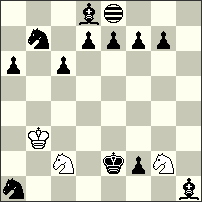 |
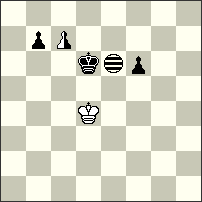 |
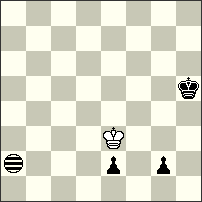 |
| h#2 2 solutions (3+12+1i) Imitator e8 |
h#3 (1+3+1+1i) b) Pb7→f5, c) Kd4→b5, d) Pf6→c2 Imitator e6 |
h#4 2 solutions (3+1+1i) Imitator h2 |
4th Prize – No.46 Mario Parrinello. A super unusual problem: two different Rundlauf-like movements in opposite directions by the Imitator (Id6–d5–f6–e8 in the first phase, then If6–e5–d6–e8 in the second phase). A curious synthesis of this theme with Zilahi! I.1.Sb7-a5[Id6] + Kb3-b2[Id5] 2.Sa1*c2[If6] Sg2-f4[Ie8] #; II. 1.Sb7-c5[If6] + Kb3-a2[Ie5] 2.Bh1*g2[Id6] Sc2-d4[Ie8] #
5th Prize – No.48 Valerio Agostini. In white “Rex solus” form and with only 5 men on the board + 1 Imitator the author demonstrates an interesting and difficult concept – neutral AUW of nPc7 plus 4 different mates given by the w.King on its last move! a) 1.Kd6-c6[Id6] Kd4-e4[Ie6] 2.Kc6-c5[Ie5] nPc7-c8 [Ie6]=nB 3.nBc8-d7[If5] Ke4-d5[Ie6]#; b)1.Kd6-d7[Ie7] nPc7-c8[Ie8]=nR 2.nRc8-b8[Id8] Kd4-c4[Ic8] 3.nRb8-b7[Ic7] Kc4-d5[Id8] #; c) 1.f6-f5[Ie5] Kb5-b4[Ie4] 2.Kd6-c6[Id4] nPc7-c8[Id5]=nQ + 3.nQc8-d8[Ie5] Kb4-c5[If6] #; d) 1.b7-b5[Ie4] Kd4-d3[Ie3] 2.b5-b4[Ie2] nPc7-c8[Ie3]=nS + 3.Kd6-c5[Id2] Kd3-c4[Ic3] #
6th Prize – No.36 Pierre Tritten. A very pleasant problem, in which the author demonstrates with minimal material interesting content: interchange of functions between black Pawns (promotion to Imitator / promotion to piece blocking promoted Imitator! For example: in the first solution 5.Kxg5? is not possible because the Ie4 is blocked by Sd4 and the movement Ie4-d4 is impossible; in the second solution 5.Kh5? is not possible because the Ie2 is blocked by Be3 and the movement Ie2-e3 is impossible. I. 1.e2-e1[Ia1]=S Ke3-f4[Ib2] 2.Se1-f3[Ic4] Kf4-g3[Id3] 3.g2-g1[Id2]=I Kg3-f4 [Ic3,f2] 4.Sf3-d4[Ia4,d3] Kf4-g5[Ib5,e4] #;II.1.g2-g1[Ia1]=B Ke3-f3[Ib1] 2.Bg1-f2[Ia2] Kf3-g2[Ib1] 3.Bf2-e3[Ia2] Kg2-g3[Ia3] 4.e2-e1[Ia2]=I Kg3-g4[Ia3,e2] #.
| No.33 Geoff Foster Australia Christmas Blitz JF-2014 Section A Special Prize |
No.70 Manfred Rittirsch Germany Christmas Blitz JF-2014 Section A Special Prize |
No.45 Juraj Lörinc Slovakia Christmas Blitz JF-2014 Section A Special Prize |
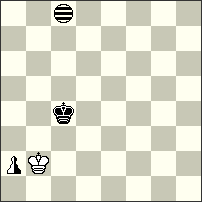 |
 |
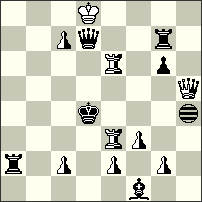 |
| h#4 2 solutions (1+1+1+1i) Imitator c8 |
h==2 (4+6+1i) Imitator g8 |
h#2.5 (1+6+8+1i) b) -e2, c) =b) -c7, d) =c) -g6, e) =d) -g7, f) =e) -e3, g) =f) -e6, h) =g) -f1, i) =h) -a2, j) =i) -f3, k) =j) -d7, l) =k) -g2 Imitator h4 |
Special Prize – No.33 Geoff Foster. At first sight – an “ordinary” four-men with two neutral under-promotions. But if we examine the content more carefully we can find a paradoxical theme – great manoeuvres of the white and black king, which in each solution make a total of 6 different moves! This great “King’s activity” is combined with two wonderful promotions to R and B which make two far from obvious moves during the solutions, respectively: 3…nRa1-h1[Ih7] and 3…nBa1-e5[Ig8] ! I. 1.nPa2-a1[Ic7]=nR Kb2-a3[Ib8] 2.Kc4-c3[Ib7] Ka3-a4[Ib8] 3.Kc3-b2[Ia7] nRa1-h1[Ih7] 4.Kb2-a2[Ig7] Ka4-b3[Ih6] #; II. 1.nPa2-a1[Ic7]=nB + Kb2-c1[Id6] 2.Kc4-b3[Ic5] Kc1-d1[Id5] 3.Kb3-a2[Ic4] nBa1-e5[Ig8] 4.Ka2-b1[Ih7] Kd1-c2[Ig8] #
Special Prize – No.70 Manfred Rittirsch. A sensational concept: H== with 4 half-moves all of which are promotions only to imitators! The order of production is interestingly motivated through illegal self-checks to both Kings. For example: 1.f2-f1[Ig7]=I? is illegal because the b.Ka8 is in self-check from Pb7; after 1.c2-c1[Ig7]=I, 2.e7-e8[Ig8,c2]=I is illegal because the w.Ke1 is in self-check from Sg2. Correct is only: 1.c2-c1[Ig7]=I b7-b8[Ig8,c2]=I 2.f2-f1[Ig7,c1,b7]=I e7-e8 [Ig8,c2,b8,f2]=I ==!
Special Prize – No.45 Juraj Lörinc. An exotic concept that is probably very difficult for realisation. The construction seems heavy, but I do not believe that such a Task can be achieved in a milder form. The author comments: “Striptease theme in 12 phases with important additions: neutral officers play in phases where they are present, multiple-check and pin mates of varying types combining properties of Imitator and neutral pieces (many tries to parry check are refuted), super-AUW included”. a) 1…nQh5-g5[Ig4] 2.nPf3*e2[If3] + Kd8*d7[If2] 3.Kd4-e5[Ig3] Kd7-c8[If4] #; b) 1…nQh5*g6[Ig5] 2.nRe6-d6[If5] + Kd8-c8[Ie5] 3.nRe3-d3[Id5] + nQg6*d6[Ia5] #; c) 1…nQh5-f5[If4] 2.Qd7-f7[Ih4] nPc2-c3[Ih5] 3.nPg2-g1[Ih4]=nQ nQg1*e3[If6] #; d) 1…nQh5-f7[If6] 2.Qd7-d5[If4] nPg2-g4[If6] 3.Kd4-e4[Ig6] nQf7*g7[Ih6] #; e) 1…nQh5-g5[Ig4] 2.Qd7-d6[Ig3] Kd8-c7[If2] 3.Kd4-e5[Ig3] + nPg2*f3[If4] #; f) 1…Kd8*d7[Ih3] 2.Bf1-e2[Ig4] nPc2-c3[Ig5] + 3.Kd4-e5[Ih6] nPg2-g4[Ih8] #; g) 1…nQh5*f3[If2] 2.Qd7-e8[Ig3] nQf3-e2[If2] 3.Kd4-e3[Ig1] Kd8*e8[Ih1] #; h) 1…nQh5-h8[Ih7] + 2.Kd4-d3[Ih6] + nQh8-c3[Ic1] + 3.Qd7-c8[Ib2] Kd8-c7[Ia1] #; i) 1…nQh5-g5[Ig4] 2.nPg2-g1[Ig3]=I + nPc2-c3[Ig4,g2] + 3.Kd4-e4[Ih4,h2] + Kd8*d7[Ih3,h1] #; j) 1…nQh5-e8[Ie7] 2.Qd7-f5[Ig5] nQe8-f7[Ih4] 3.nPg2-g1[Ih3]=nB nQf7*f5[Ih1]#; k) 1…Kd8-c8[Ig4] 2.nPc2-c1[Ig3]=nR nRc1-d1[Ih3] 3.nPg2-g1[Ih2]=nS Kc8-c7[Ih1] #; l) 1…Kd8-c7[Ig3] 2.nPc2-c1[Ig2]=nQ + nQh5-d5[Ic2] 3.nQc1-c4[Ic5] Kc7-c8[Ic6] #
| No.34 Juraj Lörinc Slovakia Christmas Blitz JF-2014 Section A 1st Hon.men. |
No.74 Kostas Prentos USA Christmas Blitz JF-2014 Section A 2nd Hon.men. |
No.89 Oliver Sick Germany Christmas Blitz JF-2014 Section A 3rd Hon.men. |
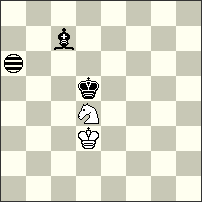 |
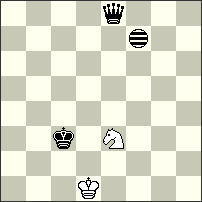 |
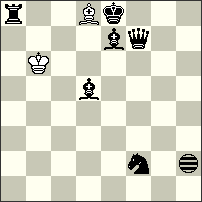 |
| h#4 2 solutions (2+2+1i) Imitator a6 |
h#3 3 solutions (2+2+1i) Imitator f7 |
h#3.5 (2+6+1i) Imitator h2; NoIProm |
1st Honorable Mention – No.34 Juraj Lörinc. Chameleon-echo model-mates in very economic form. A nice problem! But it is obvious that with only a black Bishop on the black square(s) one cannot achieve an optical chameleon – echo uniformity of the final pictures in both phases. I. 1.Kd5-e5[Ib6] Sd4-f5[Id7] 2.Ke5-f4[Ie6] Sf5-h6[Ig7] 3.Kf4-f3[Ig6] Sh6-g4[If4] 4.Bc7-d6[Ig3] Sg4-h2[Ih1] #; II. 1.Bc7-e5[Ic4] Sd4-c6[Ib6] 2.Kd5-c4[Ia5] + Kd3-e3[Ib5] 3.Kc4-c3[Ib4] Sc6-b4[Ia2] 4.Be5-f6[Ib3] Sb4-a2[Ia1] #.
2nd Honorable Mention – No.74 Kostas Prentos. Interesting play in 3 phases with good activity of all black and white pieces. Unfortunately, there is no full thematic identity between all phases. I. 1.Kc3-b2[Ie6] Se3-f1[If4] 2.Kb2-a1[Ie3] Kd1-c2[Id4] 3.Qe8-g6[If2] Kc2-b1[Ie1] #; II. 1.Qe8-e5[If4] Se3-d5[Ie6] + 2.Kc3-c4[Ie7] Kd1-c2[Id8] 3.Qe5-d4[Ic7] Sd5-b6[Ia8] #; III. 1.Qe8-b8[Ic7] Se3-c4[Ia8] 2.Kc3-c2[Ia7] + Kd1-d2[Ia8] 3.Kc2-c1[Ia7] Sc4-e5[Ic8] #
3rd Honorable Mention – No.89 Oliver Sick. A nonstandard theme – the so called “floating inder”, ie. an Indian manoeuvre which allows castling. In this case the square d8 is attacked after the critical move 2… Ba5. But after the Indian move 3… Kb6 castling is possible and it ends with a very fairy typical mate. 1…Kb6-a6[Ig2] 2.Bd5-b7[Ie4] + Bd8-a5[Ib1] 3.Qf7-g8[Ic2] + Ka6-b6[Id2] 4.0-0-0[Ie2] Kb6-c7[If3] #
| No.67 Lev Grolman& Vladislav Nefyodov Russia Christmas Blitz JF-2014 Section A 4th Hon.men. |
No.42 Chris Feather England Christmas Blitz JF-2014 Section A 5th Hon.men. Dedicated to Klaus Wenda with thanks for e-mailing this problem for me |
No.82 Arnold Beine Germany Christmas Blitz JF-2014 Section A 6th Hon.men. |
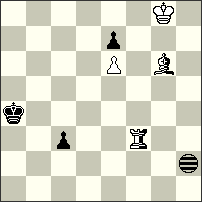 |
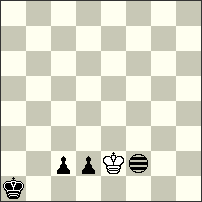 |
 |
| h#2 b) Ih2->f5 (2+3+2+1i) Imitator h2 |
h#3 b) Ka1->b3 (1+3+1i) Imitator f2 |
h==3 b) Ie5->b5 (2+2+1i) Imitator e5; NoIProm |
4th Honorable Mention – No.67 Lev Grolman& Vladislav Nefyodov. Creation of specific batteries using the nR/nB as rear pieces and Imitator + wPe6 as two forward pieces. Good and nonstandard strategy combined with Zilahi-theme. But in my opinion this complex is not presented in an optimal form – a minus is the repetition of the capture 2…exf7 though with different movements of the Imitator. I am convinced that in a different scheme this drawback can be avoided. a) 1.nBg6-e8[If4] Kg8-h7[Ig3] 2.nRf3-f7[Ig7] e6*f7[Ih8] #; b)1.nRf3-e3[Ie5] nBg6-f7[Id6] 2.nRe3-e4[Id7] + e6*f7[Ie8] #.
5th Honorable Mention – No.42 Chris Feather . Nice play with two under-promotion pairs (R,R and S,S). a) 1.c2-c1[If1]=R Ke2-d3[Ie2] 2.Rc1-c3[Ie4] + Kd3-c2[Id3] 3.d2-d1[Id2]=R Kc2-b1[Ic1] #; b) 1.d2-d1[If1]=S Ke2-d3[Ie2] 2.Kb3-a3[Id2] Kd3-c4[Ic3] 3.c2-c1[Ic2]=S Kc4-b3[Ib1] #.
6th Honorable Mention – No.82 Arnold Beine. In this “Half-Babson” (promotions: RR + BB) the double-stalemate finales are wonderful and very hard to find. Unfortunately a weakness is the repetition in both phases of Black’s move 3.Kh3. a) 1.a2-a1[Ie4]=R f7-f8[Ie5]=R 2.Ra1-a4[Ie8] Rf8-f2[Ie2] + 3.Kg2-h3[If3] + Rf2-a2[Ia3] ==; b) 1.a2-a1[Ib4]=B f7-f8[Ib5]=B 2.Ba1-d4[Ie8] Bf8-c5[Ib5] 3.Kg2-h3[Ic6] + Bc5-a7[Ia8] ==
Commendations (without rank):
| No.81 Arnold Beine Germany Christmas Blitz JF-2014 Section A Commendation |
No.84 Vlaicu Crișan Romania Christmas Blitz JF-2014 Section A Commendation |
No.16 Sébastien Luce France Christmas Blitz JF-2014 Section A Commendation |
 |
 |
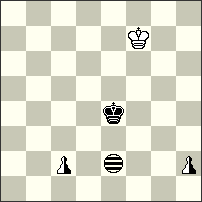 |
| h==4 b) nRf8 (1+2+1+1i) Imitator b5 |
h#3 2 solutions (1+1+2+1i) Imitator d4 Chameleon Chess |
h#3 (1+1+2+1i) b) Ke4->g2, c) Kf7->g3 Imitator e2 |
Commendation – No.81 Arnold Beine. a) 1.Kg2-h2[Ic5] Kh4-g5[Ib6] 2.nQf8-f3[Ib1] Kg5-h6[Ic2] 3.Sc1-a2[Ia3] nQf3-h1[Ic1] + 4.Kh2-g2[Ib1] + Kh6-g6[Ia1] ==; b) 1.nRf8-g8[Ic5] Kh4-h5[Ic6] 2.Kg2-h3[Id7] nRg8-g2[Id1] 3.Sc1-a2[Ib2] nRg2-h2[Ic2] + 4.Kh3-g3[Ib2] + Kh5-g4[Ia1] ==
Commendation – No.84 Vlaicu Crișan. I. 1.nPd2-d1[Id3]=nS nSd1-c3[Ic5]=nB 2.nPe2-e1[Ic4]=nQ nBc3-d2[Id3]=nR 3.Kd5-e4[Ie2] + nQe1-h1[Ih2]=nS #; II. 1.nPe2-e1[Id3]=nR nRe1-e2[Id4]=nQ 2.nPd2-d1[Id3]=nR nQe2-d2[Ic3]=nS 3.Kd5-d4[Ic2] nSd2-b1[Ia1]=nB #
Commendation – No.16 Sébastien Luce. a) 1.nPc2-c1[Ie1]=nB nBc1-e3[Ig3] 2.nPh2-h1[Ig2]=nB Kf7-f6[Ig1] 3.nBh1-g2[If2] Kf6-f5[If1] #; b) 1.nPc2-c1[Ie1]=nR Kf7-e7[Id1] 2.nRc1-c4[Id4] nRc4-g4[Ih4] 3.nPh2-h1[Ih3]=nQ Ke7-e8[Ih4] #; c) 1.nPc2-c1[Ie1]=nS nSc1-b3[Id3] 2.nPh2-h1[Id2]=nR Kg3-h3[Ie2] 3.nRh1-e1[Ib2] Kh3-g4[Ia3] #
| No.52 Stephan Dietrich Germany Christmas Blitz JF-2014 Section A Commendation |
No.25 Peter Harris South Africa Christmas Blitz JF-2014 Section A Commendation |
No.69 Vito Rallo Italy Christmas Blitz JF-2014 Section A Commendation |
 |
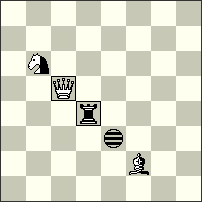 |
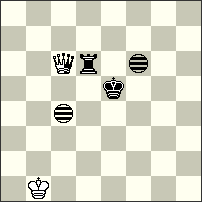 |
| h#4 b) Se3->e5 (2+2+2i) Imitators: b2, g7 |
h#3 2 solutions (1+1+2+1i) Imitator e3 Chameleon Chess White Maximummer Royal Qc5, Rd4 |
h#3 2 solutions (1+2+1+2i) Imitators: c4, f6 |
Commendation – No.52 Stephan Dietrich. a) 1.Rf5-f4[Ib1,g6] Se3-d5[Ia3,f8] 2.Rf4-g4[Ib3,g8] Sd5-c3[Ia1,f6] 3.Rg4-g6[Ia3,f8] Kd4-e4[Ib3,g8] 4.Ke6-f5[Ic2,h7] Sc3-a2[Ia1,f6] #; b) 1.Ke6-e7[Ib3,g8] Kd4-c4[Ia3,f8] 2.Rf5-f3[Ia1,f6] Se5-g6[Ic2,h7] + 3.Rf3-e3[Ib2,g7] Kc4-b3[Ia1,f6] 4.Ke7-f8[Ib2,g7] Kb3-c2[Ic1,h6] #
Commendation – No.25 Peter Harris. I. 1.nBf2-h4[Ig5]=nR rQc5-c1[Ig1]=rS 2.rRd4-c4[If1]=rQ rSc1-a2[Id2]=rB + 3.rQc4-a4[Ib2]=rS rBa2-g8[Ih8]=rR #; II. 1.rRd4-f4[Ig3]=rQ rQc5-a5[Ie3]=rS 2.rQf4-b4[Ia3]=rS rSa5-b7[Ib5]=rB 3.rSb4-a6[Ia7]=rB + nSb6-d7[Ic8]=nB #
Commendation – No.69 Vito Rallo. I. 1.Rd6-d5[Ic3,f5] Kb1-b2[Ic4,f6] 2.Rd5-b5[Ia4,d6] + Kb2-c2[Ib4,e6] 3.Ke5-d6[Ia5,d7] Kc2-c3[Ia6,d8] #; II. 1.Rd6-d7[Ic5,f7] Kb1-c1[Id5,g7] 2.nQc6-c2[Id1,g3] Kc1-d2[Ie2,h4] 3.Ke5-d4[Id1,g3] + Kd2-e3[Ie2,h4] #


I want to say a great thank you to M. Petkov and Julia for the serious and quickness in the organisation of this tourney. I felt that n°40 was interesting but I am very honoured to get 2nd prize among all these famous names as I started chess composition only in 2012. Congratulations also to Diyan the winner and to all the participants.
Sebastien Luce
Wow! So many beautiful problems. Will take me at least some weeks to realise the wonderful themes ! Thanks authors and thanks Petkov for a super-quick judgement !